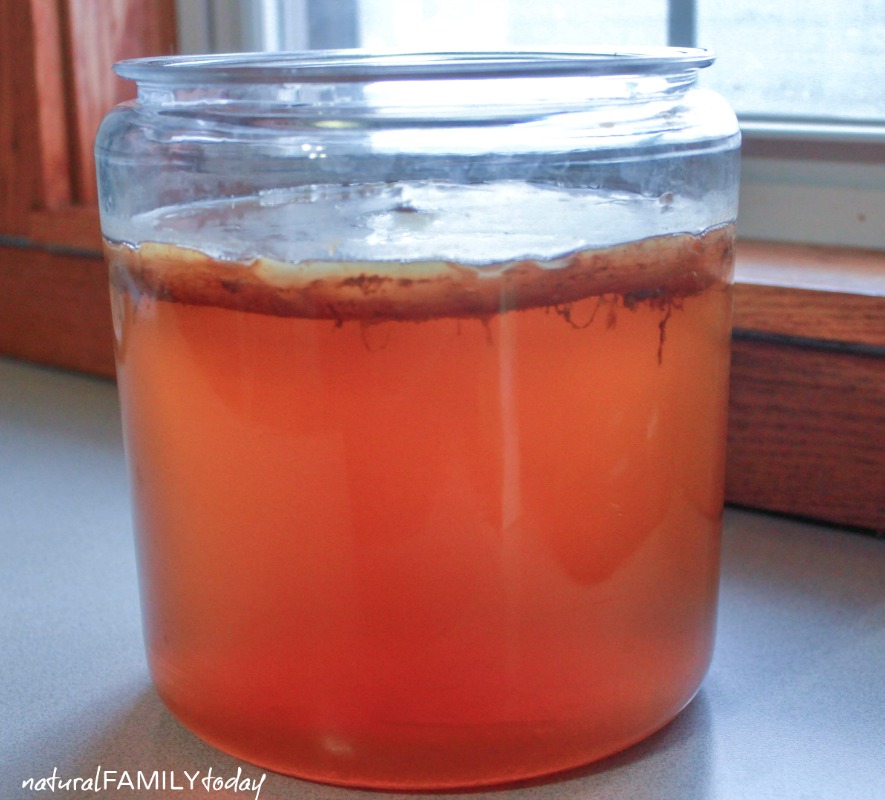Kombucha is a mysterious drink to the majority of people in the western hemisphere, though it is gaining in popularity because of it’s many health benefits.
Dubbed the “wonder drink”, kombucha is a traditional drink that is made by fermenting sweetened tea with the help of a SCOBY (which stands for “symbiotic culture of bacteria and yeast”).
Kombucha is thought to have originated in ancient China, and was brought to Russia sometime before 1910. From there it spread to Germany and various parts of Europe.
Why Drink Kombucha? Read: Top 5 Kombucha Health Benefits
You can buy kombucha in most health food stores for about $3-$5 a bottle, or you can make your own kombucha at home for a fraction of the cost – somewhere around 10-15 cents a gallon. Plus, when making kombucha at home you have many different options for flavoring.
I’ve created a video to make it easy for you to see the entire process at-a-glance. Please “like” the video if you find it helpful. Below, you will also find more detailed instructions to help you get started making your own kombucha at home!
How to Make Kombucha in 3 Easy Steps: Video Instructions
What You Need to Make Kombucha
Here’s everything you”ll need to make your own kombucha…
A Large Pot – I use a stainless steel pot to boil water for making the tea.
Water – I recommend you use filtered water, but most tap water is okay depending on where you live.
A Plate – You’ll use this to set your SCOBY on while bottling the kombucha.
3 Black Tea Bags – Some people use green tea or other teas for making kombucha. I recommend beginners stick with black tea for making kombucha.
Glass Jars and Lids – You’ll need 4-5 glass jars for bottling your kombucha. Mason jars, juice jars, or old kombucha bottles work well.
A Funnel – For bottling your kombucha without making a huge mess. (get one here)
1 Kombucha SCOBY – You can obtain a SCOBY from a friend, buy one online (I like this one), or make your own.
1 Cup Kombucha – You’ll need some premade kombucha to kickstart your culture. A good starter culture will include this. You can also use organic kombucha from the store.
Large Glass Container – You’ll need something to ferment your kombucha in. (I use this)
Frozen Fruit (optional) – It’s your choice what you want to flavor our kombucha with. We use frozen fruit, but you could use fresh fruit, fresh ginger, fruit juice, etc.
1 Cup Sugar – You will use sugar to sweeten the tea. The kombucha SCOBY “feeds” on the sugar and the caffeine in the tea.
Additional supplies: A tea towel or muslin cloth, a rubber band.
Step 1: Brewing the Tea
1.) Boil about a gallon of water in a pot on the stove (or whatever method you prefer). Steep the 3 black tea bags in the boiling water for approximately 5 minutes.
2.) While the tea is still hot, pour in 1 cup of sugar and mix thoroughly.
3.) Remove the sweetened tea from heat and allow to cool to room temperature.
Step 2: Fermentation
1.) Add one cup of premade kombucha and yourkombucha SCOBY to a large glass jar or container.
2.) Pour the room temperature tea into the glass container.
3.) Cover the glass container with a clean tea towel or muslin cloth. Secure with a rubber band.
4.) Allow the tea to ferment on the counter for 5-7 days. Exact fermentation times will depend largely on the temperature of the fermentation location and the strength of your SCOBY culture.
How to Tell When Your Kombucha is Ready
This is the one variable that makes people nervous when making their own kombucha. How do you tell when it’s ready?
That answer is, it depends on your preferences. Some people can handle a slightly more acidic kombucha, and some can not. I prefer my kombucha similar to what you would buy at the store.
The best way to find out if your kombucha is ready is to start tasting it daily, starting at about 5 days.
On day 5, use a clean spoon to taste your kombucha. Dip the spoon down into your kombucha and swirl it around a bit to distribute the taste evenly. Then, taste it!
If your kombucha still tastes like sweet tea, it’s not ready. Finished kombucha does not taste “sugary”. It has a slight acidic/vinegar taste, and will probably taste slightly carbonated. Think of the taste of a flat soda that still has a bit of carbonation left, but not much.
The longer your kombucha ferments, the more tart and acidic it will taste.

Step 3: Bottling the Kombucha
1.) Add one piece of frozen fruit to each jar. You can also use ginger, fruit juice, fresh fruit, or nothing at all.
2.) With clean hands, remove the kombucha SCOBY from the fermentation jar and place on a clean plate.
3.) Pour your finished kombucha into the glass jars with the help of a funnel. Reserve at least 1 cup of kombucha for the next batch.
4.) Cap jars loosely and refrigerate. Advanced brewers may wish to do an optional second ferment, which adds more carbonation to the finished product.
~
Additional Notes:
After your first few batches of kombucha, your SCOBY will multiply, producing new SCOBYs.
There are several things you can do with these additional SCOBYs: Make more kombucha, pass them on to friends (along with 1 cup of starter brew), use them to fertilize your garden, compost them, etc.
Pin it here:



